Aligning Objectives to Standards: Lesson Plan Development
VerifiedAdded on 2022/08/18
|7
|1033
|24
Homework Assignment
AI Summary
This assignment presents lesson plans across different grade levels, emphasizing the crucial skill of aligning objectives with educational standards. The student-created lesson plans demonstrate the application of Bloom's Taxonomy across various subjects, including English handwriting, mathematics, science, and music. The assignment requires creating content and language objectives for kindergarten, 3rd, and 5th-grade levels based on provided standards, utilizing the ABCD method, and suggesting related activities. Furthermore, it underscores the importance of understanding standards, objectives, and their alignment in effective lesson planning, referencing resources such as the Kansas College and Career Ready Standards. The assignment helps teachers to create effective lesson plans and teach students in an organized way.
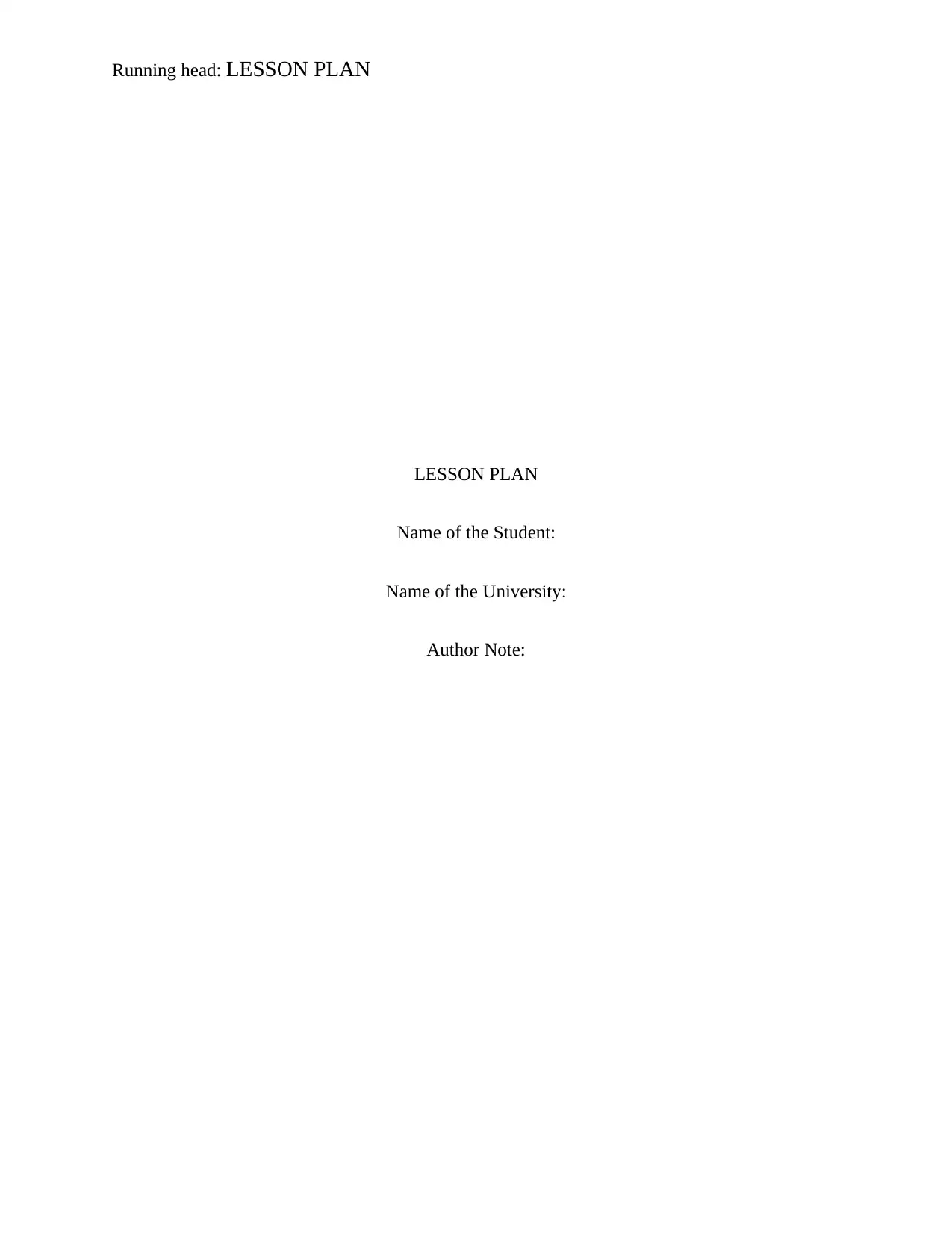
Running head: LESSON PLAN
LESSON PLAN
Name of the Student:
Name of the University:
Author Note:
LESSON PLAN
Name of the Student:
Name of the University:
Author Note:
Paraphrase This Document
Need a fresh take? Get an instant paraphrase of this document with our AI Paraphraser
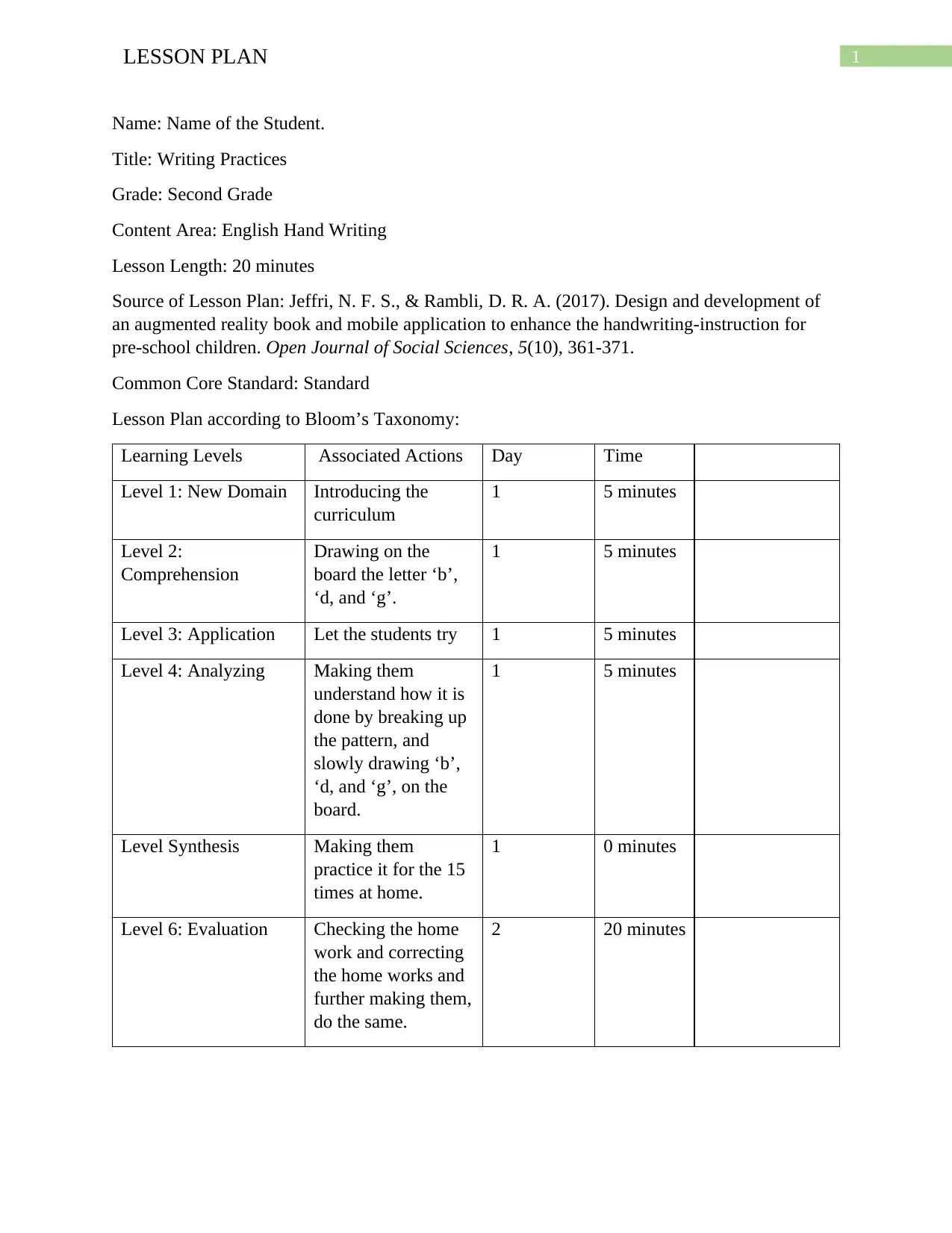
1LESSON PLAN
Name: Name of the Student.
Title: Writing Practices
Grade: Second Grade
Content Area: English Hand Writing
Lesson Length: 20 minutes
Source of Lesson Plan: Jeffri, N. F. S., & Rambli, D. R. A. (2017). Design and development of
an augmented reality book and mobile application to enhance the handwriting-instruction for
pre-school children. Open Journal of Social Sciences, 5(10), 361-371.
Common Core Standard: Standard
Lesson Plan according to Bloom’s Taxonomy:
Learning Levels Associated Actions Day Time
Level 1: New Domain Introducing the
curriculum
1 5 minutes
Level 2:
Comprehension
Drawing on the
board the letter ‘b’,
‘d, and ‘g’.
1 5 minutes
Level 3: Application Let the students try 1 5 minutes
Level 4: Analyzing Making them
understand how it is
done by breaking up
the pattern, and
slowly drawing ‘b’,
‘d, and ‘g’, on the
board.
1 5 minutes
Level Synthesis Making them
practice it for the 15
times at home.
1 0 minutes
Level 6: Evaluation Checking the home
work and correcting
the home works and
further making them,
do the same.
2 20 minutes
Name: Name of the Student.
Title: Writing Practices
Grade: Second Grade
Content Area: English Hand Writing
Lesson Length: 20 minutes
Source of Lesson Plan: Jeffri, N. F. S., & Rambli, D. R. A. (2017). Design and development of
an augmented reality book and mobile application to enhance the handwriting-instruction for
pre-school children. Open Journal of Social Sciences, 5(10), 361-371.
Common Core Standard: Standard
Lesson Plan according to Bloom’s Taxonomy:
Learning Levels Associated Actions Day Time
Level 1: New Domain Introducing the
curriculum
1 5 minutes
Level 2:
Comprehension
Drawing on the
board the letter ‘b’,
‘d, and ‘g’.
1 5 minutes
Level 3: Application Let the students try 1 5 minutes
Level 4: Analyzing Making them
understand how it is
done by breaking up
the pattern, and
slowly drawing ‘b’,
‘d, and ‘g’, on the
board.
1 5 minutes
Level Synthesis Making them
practice it for the 15
times at home.
1 0 minutes
Level 6: Evaluation Checking the home
work and correcting
the home works and
further making them,
do the same.
2 20 minutes
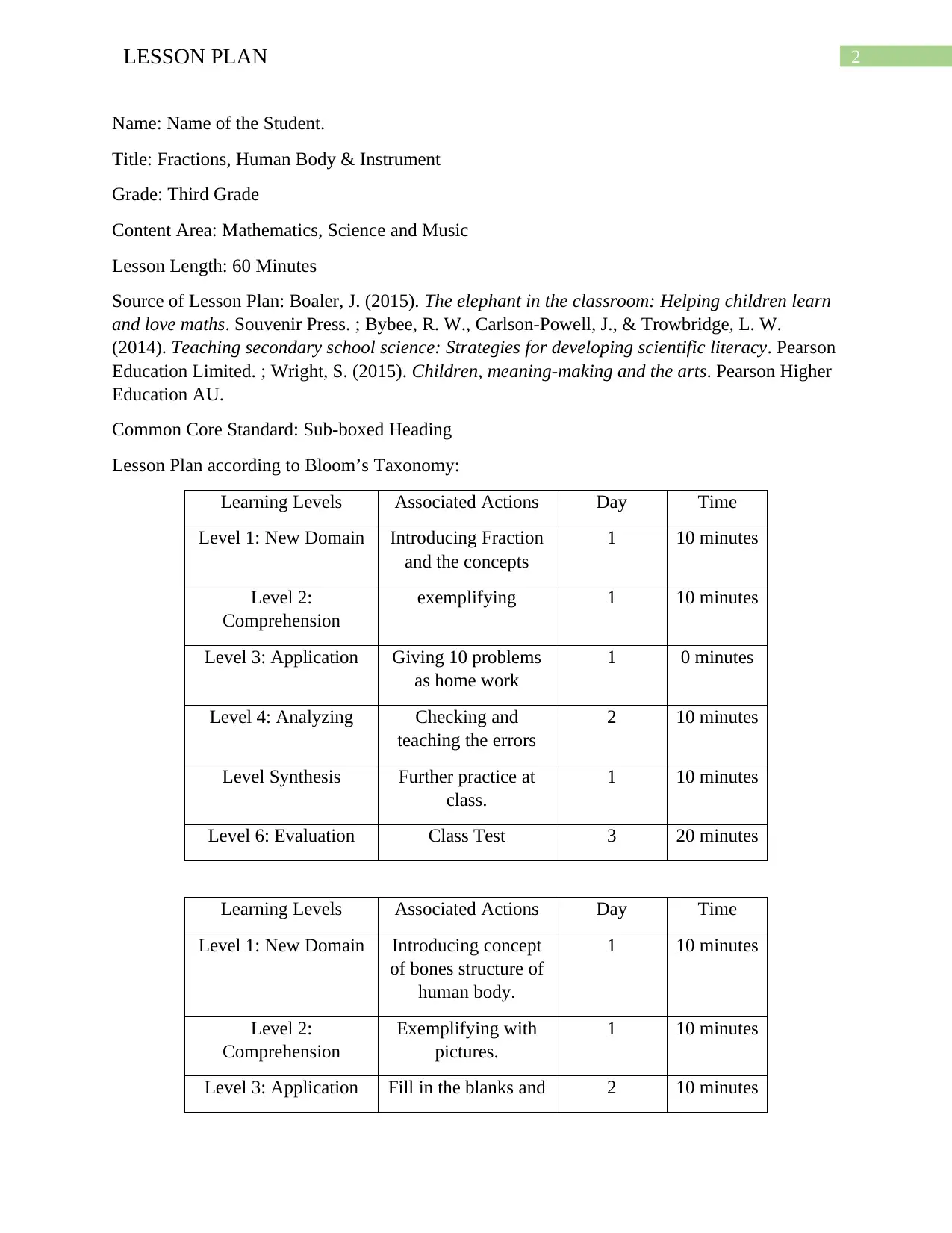
2LESSON PLAN
Name: Name of the Student.
Title: Fractions, Human Body & Instrument
Grade: Third Grade
Content Area: Mathematics, Science and Music
Lesson Length: 60 Minutes
Source of Lesson Plan: Boaler, J. (2015). The elephant in the classroom: Helping children learn
and love maths. Souvenir Press. ; Bybee, R. W., Carlson-Powell, J., & Trowbridge, L. W.
(2014). Teaching secondary school science: Strategies for developing scientific literacy. Pearson
Education Limited. ; Wright, S. (2015). Children, meaning-making and the arts. Pearson Higher
Education AU.
Common Core Standard: Sub-boxed Heading
Lesson Plan according to Bloom’s Taxonomy:
Learning Levels Associated Actions Day Time
Level 1: New Domain Introducing Fraction
and the concepts
1 10 minutes
Level 2:
Comprehension
exemplifying 1 10 minutes
Level 3: Application Giving 10 problems
as home work
1 0 minutes
Level 4: Analyzing Checking and
teaching the errors
2 10 minutes
Level Synthesis Further practice at
class.
1 10 minutes
Level 6: Evaluation Class Test 3 20 minutes
Learning Levels Associated Actions Day Time
Level 1: New Domain Introducing concept
of bones structure of
human body.
1 10 minutes
Level 2:
Comprehension
Exemplifying with
pictures.
1 10 minutes
Level 3: Application Fill in the blanks and 2 10 minutes
Name: Name of the Student.
Title: Fractions, Human Body & Instrument
Grade: Third Grade
Content Area: Mathematics, Science and Music
Lesson Length: 60 Minutes
Source of Lesson Plan: Boaler, J. (2015). The elephant in the classroom: Helping children learn
and love maths. Souvenir Press. ; Bybee, R. W., Carlson-Powell, J., & Trowbridge, L. W.
(2014). Teaching secondary school science: Strategies for developing scientific literacy. Pearson
Education Limited. ; Wright, S. (2015). Children, meaning-making and the arts. Pearson Higher
Education AU.
Common Core Standard: Sub-boxed Heading
Lesson Plan according to Bloom’s Taxonomy:
Learning Levels Associated Actions Day Time
Level 1: New Domain Introducing Fraction
and the concepts
1 10 minutes
Level 2:
Comprehension
exemplifying 1 10 minutes
Level 3: Application Giving 10 problems
as home work
1 0 minutes
Level 4: Analyzing Checking and
teaching the errors
2 10 minutes
Level Synthesis Further practice at
class.
1 10 minutes
Level 6: Evaluation Class Test 3 20 minutes
Learning Levels Associated Actions Day Time
Level 1: New Domain Introducing concept
of bones structure of
human body.
1 10 minutes
Level 2:
Comprehension
Exemplifying with
pictures.
1 10 minutes
Level 3: Application Fill in the blanks and 2 10 minutes
⊘ This is a preview!⊘
Do you want full access?
Subscribe today to unlock all pages.

Trusted by 1+ million students worldwide
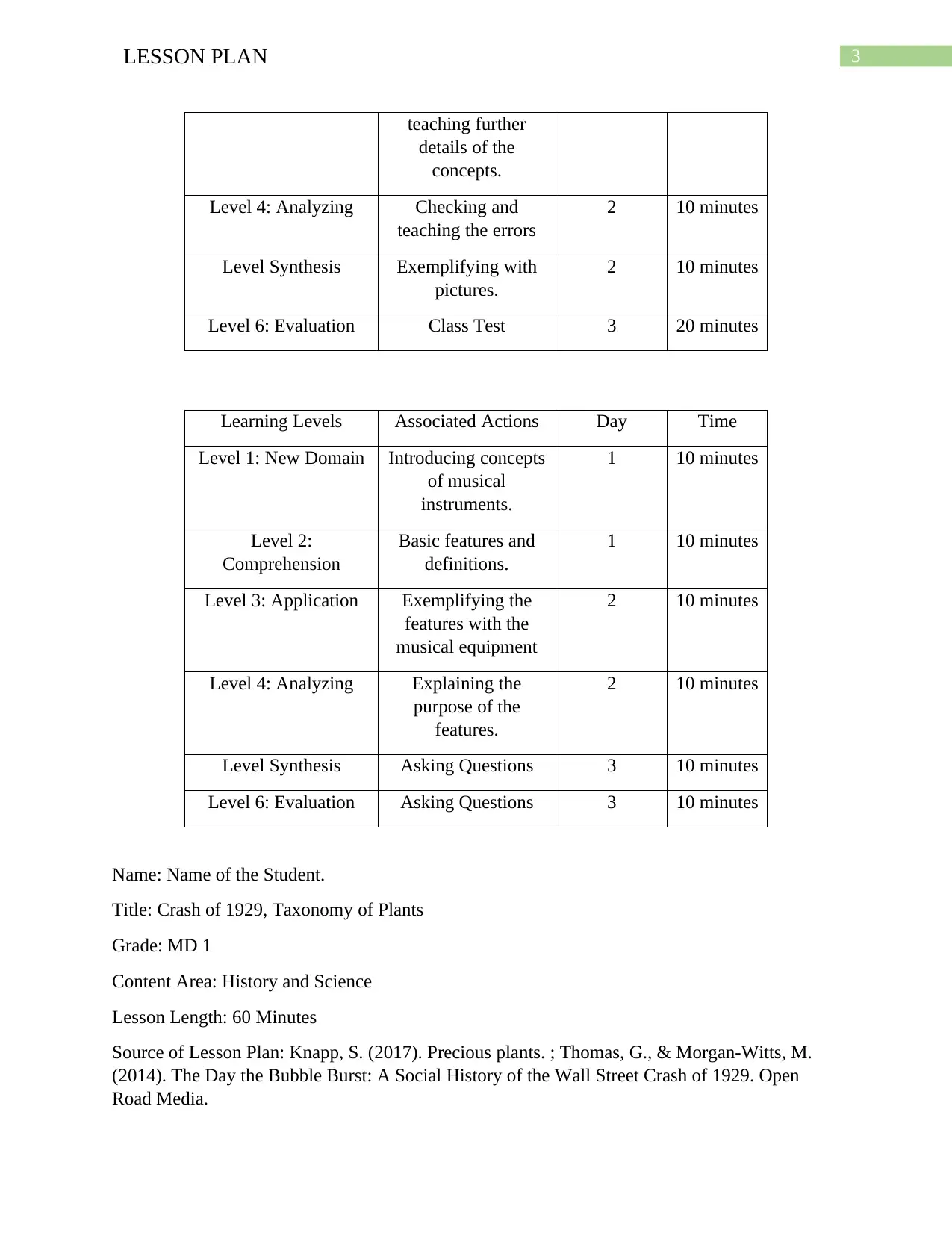
3LESSON PLAN
teaching further
details of the
concepts.
Level 4: Analyzing Checking and
teaching the errors
2 10 minutes
Level Synthesis Exemplifying with
pictures.
2 10 minutes
Level 6: Evaluation Class Test 3 20 minutes
Learning Levels Associated Actions Day Time
Level 1: New Domain Introducing concepts
of musical
instruments.
1 10 minutes
Level 2:
Comprehension
Basic features and
definitions.
1 10 minutes
Level 3: Application Exemplifying the
features with the
musical equipment
2 10 minutes
Level 4: Analyzing Explaining the
purpose of the
features.
2 10 minutes
Level Synthesis Asking Questions 3 10 minutes
Level 6: Evaluation Asking Questions 3 10 minutes
Name: Name of the Student.
Title: Crash of 1929, Taxonomy of Plants
Grade: MD 1
Content Area: History and Science
Lesson Length: 60 Minutes
Source of Lesson Plan: Knapp, S. (2017). Precious plants. ; Thomas, G., & Morgan-Witts, M.
(2014). The Day the Bubble Burst: A Social History of the Wall Street Crash of 1929. Open
Road Media.
teaching further
details of the
concepts.
Level 4: Analyzing Checking and
teaching the errors
2 10 minutes
Level Synthesis Exemplifying with
pictures.
2 10 minutes
Level 6: Evaluation Class Test 3 20 minutes
Learning Levels Associated Actions Day Time
Level 1: New Domain Introducing concepts
of musical
instruments.
1 10 minutes
Level 2:
Comprehension
Basic features and
definitions.
1 10 minutes
Level 3: Application Exemplifying the
features with the
musical equipment
2 10 minutes
Level 4: Analyzing Explaining the
purpose of the
features.
2 10 minutes
Level Synthesis Asking Questions 3 10 minutes
Level 6: Evaluation Asking Questions 3 10 minutes
Name: Name of the Student.
Title: Crash of 1929, Taxonomy of Plants
Grade: MD 1
Content Area: History and Science
Lesson Length: 60 Minutes
Source of Lesson Plan: Knapp, S. (2017). Precious plants. ; Thomas, G., & Morgan-Witts, M.
(2014). The Day the Bubble Burst: A Social History of the Wall Street Crash of 1929. Open
Road Media.
Paraphrase This Document
Need a fresh take? Get an instant paraphrase of this document with our AI Paraphraser
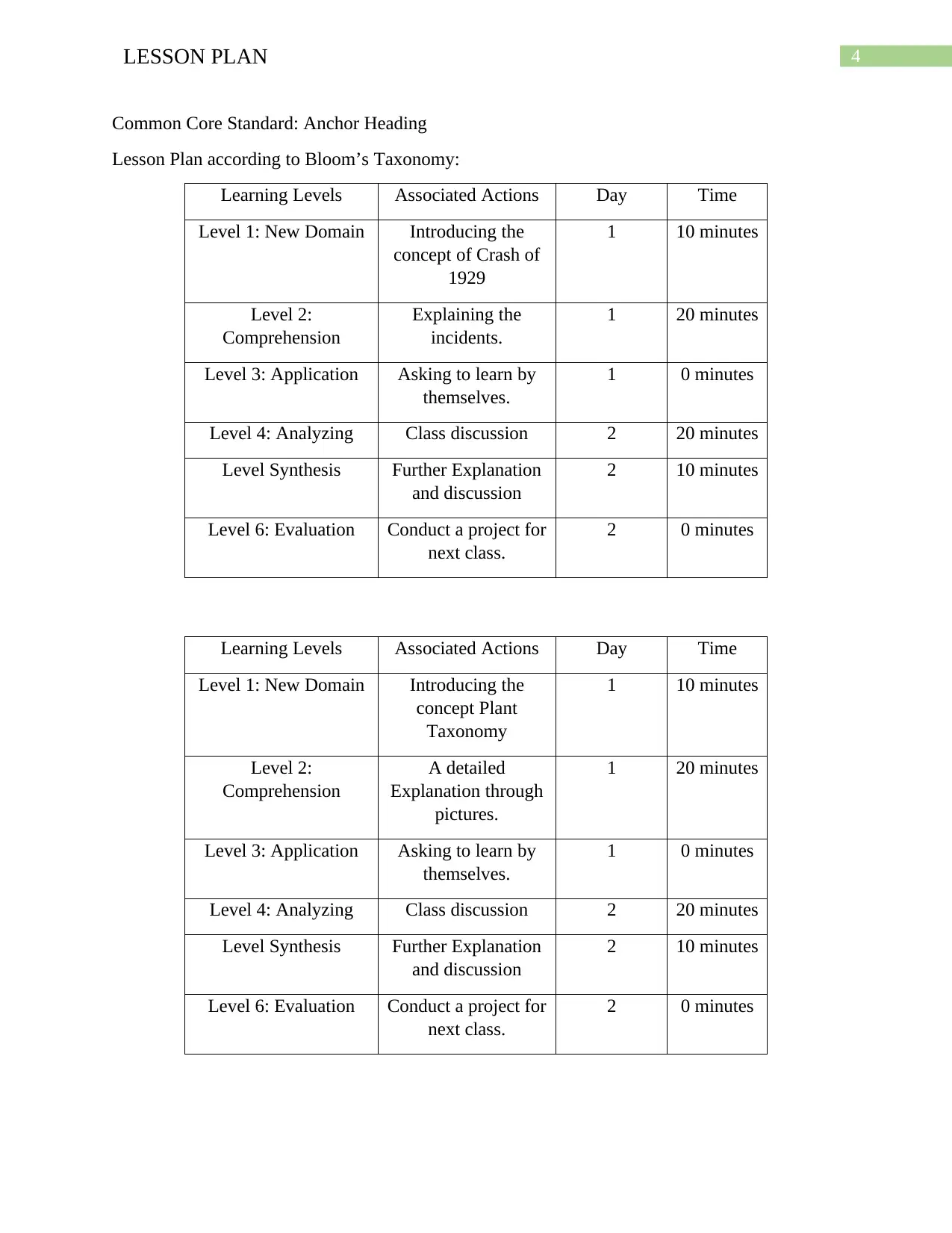
4LESSON PLAN
Common Core Standard: Anchor Heading
Lesson Plan according to Bloom’s Taxonomy:
Learning Levels Associated Actions Day Time
Level 1: New Domain Introducing the
concept of Crash of
1929
1 10 minutes
Level 2:
Comprehension
Explaining the
incidents.
1 20 minutes
Level 3: Application Asking to learn by
themselves.
1 0 minutes
Level 4: Analyzing Class discussion 2 20 minutes
Level Synthesis Further Explanation
and discussion
2 10 minutes
Level 6: Evaluation Conduct a project for
next class.
2 0 minutes
Learning Levels Associated Actions Day Time
Level 1: New Domain Introducing the
concept Plant
Taxonomy
1 10 minutes
Level 2:
Comprehension
A detailed
Explanation through
pictures.
1 20 minutes
Level 3: Application Asking to learn by
themselves.
1 0 minutes
Level 4: Analyzing Class discussion 2 20 minutes
Level Synthesis Further Explanation
and discussion
2 10 minutes
Level 6: Evaluation Conduct a project for
next class.
2 0 minutes
Common Core Standard: Anchor Heading
Lesson Plan according to Bloom’s Taxonomy:
Learning Levels Associated Actions Day Time
Level 1: New Domain Introducing the
concept of Crash of
1929
1 10 minutes
Level 2:
Comprehension
Explaining the
incidents.
1 20 minutes
Level 3: Application Asking to learn by
themselves.
1 0 minutes
Level 4: Analyzing Class discussion 2 20 minutes
Level Synthesis Further Explanation
and discussion
2 10 minutes
Level 6: Evaluation Conduct a project for
next class.
2 0 minutes
Learning Levels Associated Actions Day Time
Level 1: New Domain Introducing the
concept Plant
Taxonomy
1 10 minutes
Level 2:
Comprehension
A detailed
Explanation through
pictures.
1 20 minutes
Level 3: Application Asking to learn by
themselves.
1 0 minutes
Level 4: Analyzing Class discussion 2 20 minutes
Level Synthesis Further Explanation
and discussion
2 10 minutes
Level 6: Evaluation Conduct a project for
next class.
2 0 minutes

5LESSON PLAN
References:
Boaler, J. (2015). The elephant in the classroom: Helping children learn and love maths.
Souvenir Press.
References:
Boaler, J. (2015). The elephant in the classroom: Helping children learn and love maths.
Souvenir Press.
⊘ This is a preview!⊘
Do you want full access?
Subscribe today to unlock all pages.

Trusted by 1+ million students worldwide
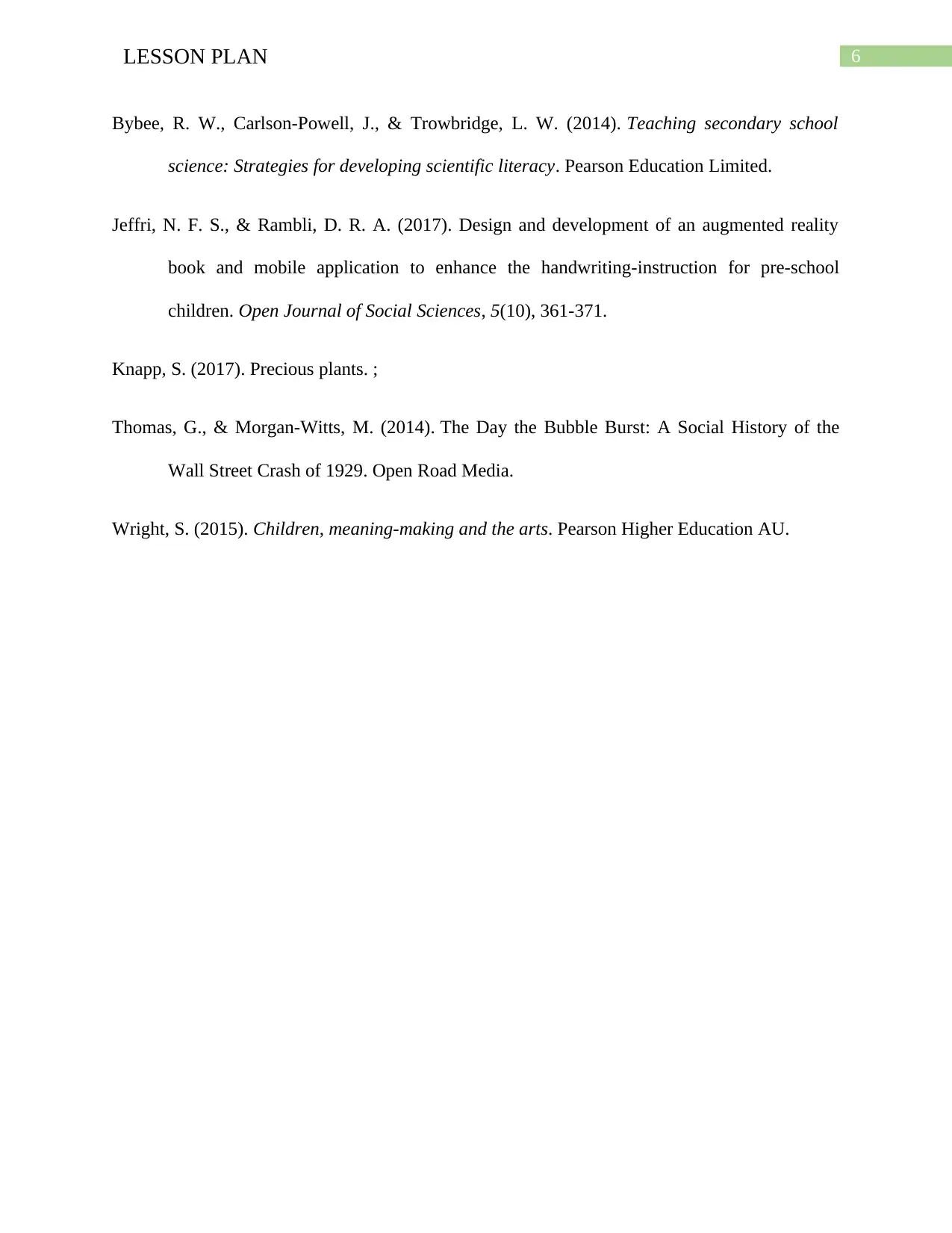
6LESSON PLAN
Bybee, R. W., Carlson-Powell, J., & Trowbridge, L. W. (2014). Teaching secondary school
science: Strategies for developing scientific literacy. Pearson Education Limited.
Jeffri, N. F. S., & Rambli, D. R. A. (2017). Design and development of an augmented reality
book and mobile application to enhance the handwriting-instruction for pre-school
children. Open Journal of Social Sciences, 5(10), 361-371.
Knapp, S. (2017). Precious plants. ;
Thomas, G., & Morgan-Witts, M. (2014). The Day the Bubble Burst: A Social History of the
Wall Street Crash of 1929. Open Road Media.
Wright, S. (2015). Children, meaning-making and the arts. Pearson Higher Education AU.
Bybee, R. W., Carlson-Powell, J., & Trowbridge, L. W. (2014). Teaching secondary school
science: Strategies for developing scientific literacy. Pearson Education Limited.
Jeffri, N. F. S., & Rambli, D. R. A. (2017). Design and development of an augmented reality
book and mobile application to enhance the handwriting-instruction for pre-school
children. Open Journal of Social Sciences, 5(10), 361-371.
Knapp, S. (2017). Precious plants. ;
Thomas, G., & Morgan-Witts, M. (2014). The Day the Bubble Burst: A Social History of the
Wall Street Crash of 1929. Open Road Media.
Wright, S. (2015). Children, meaning-making and the arts. Pearson Higher Education AU.
1 out of 7
Related Documents
Your All-in-One AI-Powered Toolkit for Academic Success.
+13062052269
info@desklib.com
Available 24*7 on WhatsApp / Email
![[object Object]](/_next/static/media/star-bottom.7253800d.svg)
Unlock your academic potential
Copyright © 2020–2025 A2Z Services. All Rights Reserved. Developed and managed by ZUCOL.





